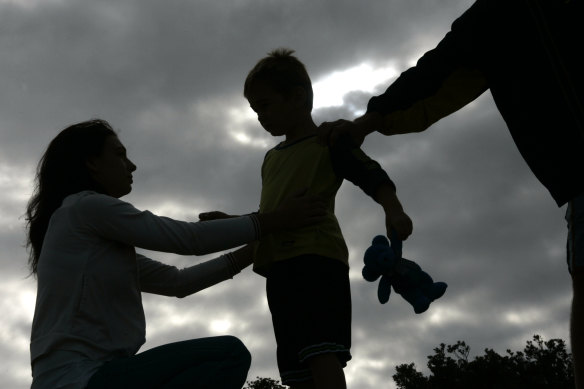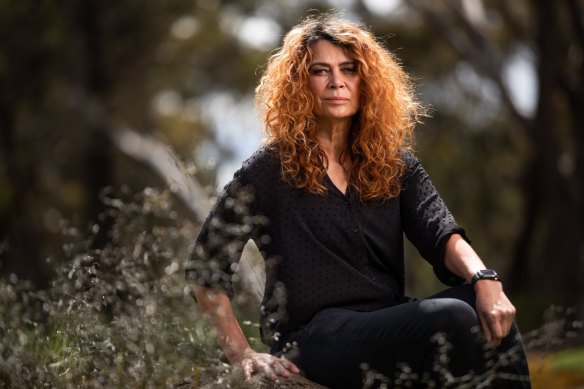- Exclusive
- National
- Victoria
- Indigenous
Child protection ‘ripped’ Aboriginal child from mother’s arms at Indigenous women’s meeting
By Wendy Tuohy
The forced removal of an Aboriginal child from their mother’s arms in front of other parents was “just about as bad as it gets” in the mishandling of First Nations family welfare, Indigenous leaders say.
A non-Indigenous child-protection worker from the Victorian Department of Families, Fairness and Housing walked into a central Victorian Aboriginal centre and took the child from the mother, who was attending a meeting. Three people with knowledge of the incident verified that it occurred but could not provide more detail because of the sensitivity and legal issues associated with the case.

More Aboriginal children are being removed from their mothers now than in the stolen generations, says Yoorrook Justice Commission deputy chair Sue-Anne Hunter.Credit: Angela Wylie
“For a child-protection worker to walk into a women’s meeting – which should be the safest place for mums and young kids to be – and rip an Aboriginal child from their mum’s arms in such a public way shows a breathtaking lack of care, respect, cultural sensitivity or common decency,” said Antoinette Braybrook, of the Aboriginal family violence and legal service, Djirra.
“Child protection is not about protecting our kids,” she said. “How does ripping a child from their mother’s arms during a women’s group do that? It doesn’t, it creates more trauma, distrust, fear and stress for women and kids across our communities.”
Braybrook said several women aware of the incident had contacted the organisation to express concern, saying women who had considered the Aboriginal-run centre safe might no longer feel they could attend. It could make at-risk women afraid to engage with services, they said.
“That place, which should be seen as safe for mums and kids, won’t seem that way now,” one woman said.
An independent source, who could not be named because they are not authorised to speak publicly, verified the incident occurred because the child was deemed to be in an unsafe situation. The child was removed to kinship care and a family reunification plan was under way.
A spokesperson from the department said: “We know more needs to be done to address the over-representation of Aboriginal children in out-of-home care – that’s why we have delivered legislation and system changes that put Aboriginal community services at the front and centre of decision-making and the delivery of services for Aboriginal children.”
But Sue-Anne Hunter, deputy chair of the Yoorrook Justice Commission, which is investigating injustice against First Nations people, said Aboriginal children in Victoria were being removed from their mothers at greater rates than in the stolen generations.
“Victoria’s child-protection system isn’t broken, it’s working exactly as it was intended to, based on its colonial foundations which saw the widespread destruction of Aboriginal families and communities. The unbroken line of injustice that started with colonisation continues,” Hunter said.

Djirra CEO Antoinette Braybrook said a department worker taking a child from their mother’s arms in a public place “shows a breathtaking lack of care, respect, cultural sensitivity, or common decency”.Credit: Jason South
“One in 10 Aboriginal children in Victoria live in out-of-home care. If that rate was applied to the entire population, it would be a national crisis. Instead, it is a forgotten crisis. Every number is a child with a family who loves them.”
Hunter said First Peoples needed a child-protection system focused on prevention, and early intervention that supported families staying together where possible. Removal must be “the last, not first, resort”.
Meena Singh, Commissioner for Aboriginal Children and Young People in Victoria, said of the 9000 children in out-of-home care, 2700 – nearly one-third – were Aboriginal, even though Aboriginal people made up only 1 per cent of Victoria’s population.
“Kids in the stolen generations were removed from hospitals, kids were removed from schools, kids were removed from places most of the community thinks of as safe,” Singh said. “The fears [of the stolen generations] have been backed up by actions of removal at some places where [now] people should feel safe.”
Family violence was one of the main reasons Aboriginal children were removed, Singh said. As a result, “we often see Aboriginal women having an unfair burden put on them to provide protection for their children when they are also victims of family violence”.
“Removal of a child is often what’s done instead of working with families,” Singh said. “I often hear about Aboriginal families, parents and children being difficult to engage with, without any understanding of the trauma many of the family have been through, and how that impacts on [mothers’] decision-making, what actions you take.”
Sarah Gafforini, of the Victorian Aboriginal Childcare Agency – one of two Aboriginal Community-Controlled Organisations authorised in 2021 to pilot Indigenous-led child-protection investigations – said she could not comment on a specific incident, but if a woman’s home environment was deemed unsafe for the child, “it is in the interests of the department to make that home environment safe”.
When victim-survivors allow a man using violence back into the house multiple times, for example, “the state is responsible for keeping that child safe”.
About 60 per cent of child-protection investigations that can lead to children being removed to out-of-home care have family violence as a factor, but since the Victorian Aboriginal Childcare Agency began intensive engagement with the whole family, of 52 families it has worked with, “we have probably saved about 40 kids from being removed”.
The department spokesperson said Victoria had the highest rate of Aboriginal children placed in kinship care in the country, with 80 per cent of children placed with Aboriginal relatives, non-Aboriginal relatives or with an Aboriginal carer, compared to the national average of 63.4 per cent.
Hunter said the evidence on self-determination heard by Yoorrook was clear: “First Peoples need to have the power, control and resources to make decisions about the issues that affect our lives.”
The Morning Edition newsletter is our guide to the day’s most important and interesting stories, analysis and insights. Sign up here.